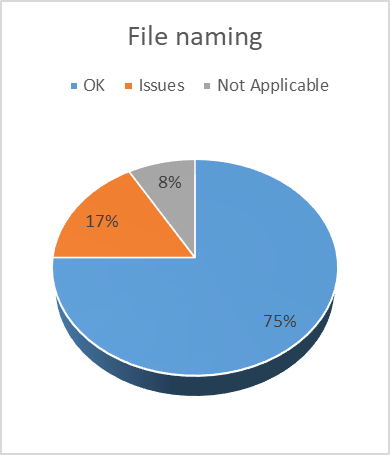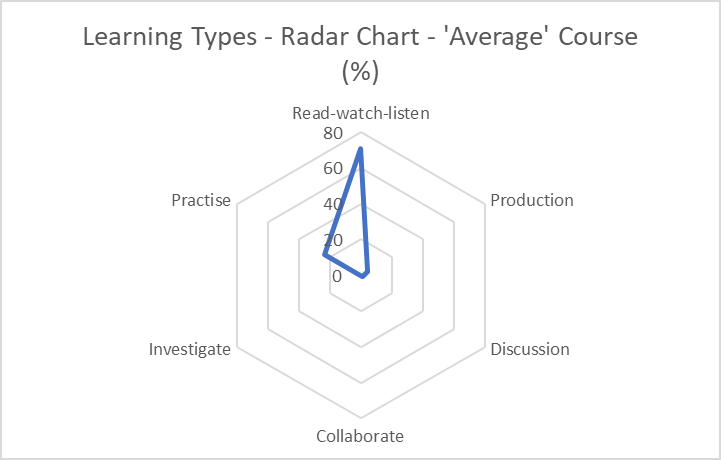
In this ‘Spotlight on Learn Foundations’ post, Neil Davidson, a Learning Technologist in Edinburgh Law School, shares his experiences of analysing courses in the Learn Virtual Learning Environment (VLE) as part of the Learn Foundations project…
How well do we know our courses in the VLE? That’s not designed to be a trick question, but it’s also not as straightforward as it might seem.
For example, what types of learning materials make up our courses? How broad is the range of activities that students undertake? How do they compare with others in the same programme? Or in the same School? Do students have a consistent experience across our courses? And do they take courses in other Schools too? How much learning actually takes place in the VLE?
I’m a Learning Technologist based in Edinburgh Law School, but over the last few months I’ve been working for a day a week with the team in Information Services on the Learn Foundations project.
Any time of change is a good point to take stock and analyse what we’re doing. So, as part of the process of moving content from the Phase 1 Schools’ 2018/19 courses to the new Learn Foundations template ready for the start of the 2019/20 academic year, I was keen to take the opportunity to explore the kinds of questions above.
One of my suggestions was to create a ‘map’ of the existing content in each course before then deciding where it would fit into the new course template. Laying it all out (in a spreadsheet, naturally) in this way might seem ponderous – surely with limited resources it would be best just to get on and do the moving, rather than meticulously logging every minute detail?
In practice, though, going through this exercise allowed us to track the whole migration process (not insignificant, given that 10 student interns were working alongside multiple staff members with varying courses across seven areas of the University). Perhaps more significantly, though, assembling this data also gave us the chance to look in some depth at what is really in those courses in the VLE, and produce some interesting and useful statistics and visualisations to help raise awareness and drive change.
We asked the Learn Foundations student interns to log and tag information about the following:
- Course menu items (including the names used).
- Course structure (including information about the various levels of the hierarchy present in the course).
- Content item type (whether each item logged is a file, a folder, a web link, a piece of text, an image or something else).
- Content learning type (how the item fits into the six categories of learning types identified by the ABC learning design framework: Acquisition, Production, Discussion, Collaboration, Investigation and Practice).

Once the numbers were in, we were able to analyse aspects of each course, and compare courses across schools, in areas such as:
- Course ‘width’ (how many menu items are there?)
- Course ‘depth’ (how many folders do students have to click through to get to the content, and how much of the course material is at each level down?)
- Course ‘weight’ (how much content is there in the course, overall?)
We were also able to visualise data to allow comparison of courses across each School or Deanery, showing:
- Content types (what proportion of the VLE content is documents, inline content, web links, tools, etc.?)
- Terminology used (how many different terms are used in navigation where one standard term would make things clearer and more consistent?)
- Learning types (what does each course, as well as a statistical ‘average’ course in the school look like, in terms of the makeup of learning types present?)

Once this had been completed, the decision was made to further extend the scope of this data collecting exercise to take in a spot-check of some of the course materials, to see how accessible they were against various measures.
The results of these exercises have given some valuable insights that the project can feed back to each School or Deanery that participated in Phase 1.
As so often with statistics, the numbers throw up a lot of further questions for academic colleagues, which they might not otherwise have considered, such as:
- If a large amount of content was identified, could this be better organised?
- What is a manageable amount of content for one course?
- Why do things vary so much from course to course?
- If course materials and learning types identified are predominantly didactic, how could we use the VLE differently to increase the variety of learning experiences?
- What would be an ideal balance of the six learning types in a course?
- How can we ensure all our content is accessible?
- How can we share good practice with our colleagues, and ensure consistency and quality of experience across Schools and Colleges?
For me, as a Learning Technologist, it is working with colleagues to explore possible answers to these kinds of questions, bringing together pedagogical and technological solutions, that I’m passionate about, and having this kind of detailed information to help start those conversations in an informed way is a real benefit of being part of the Learn Foundations Project.


